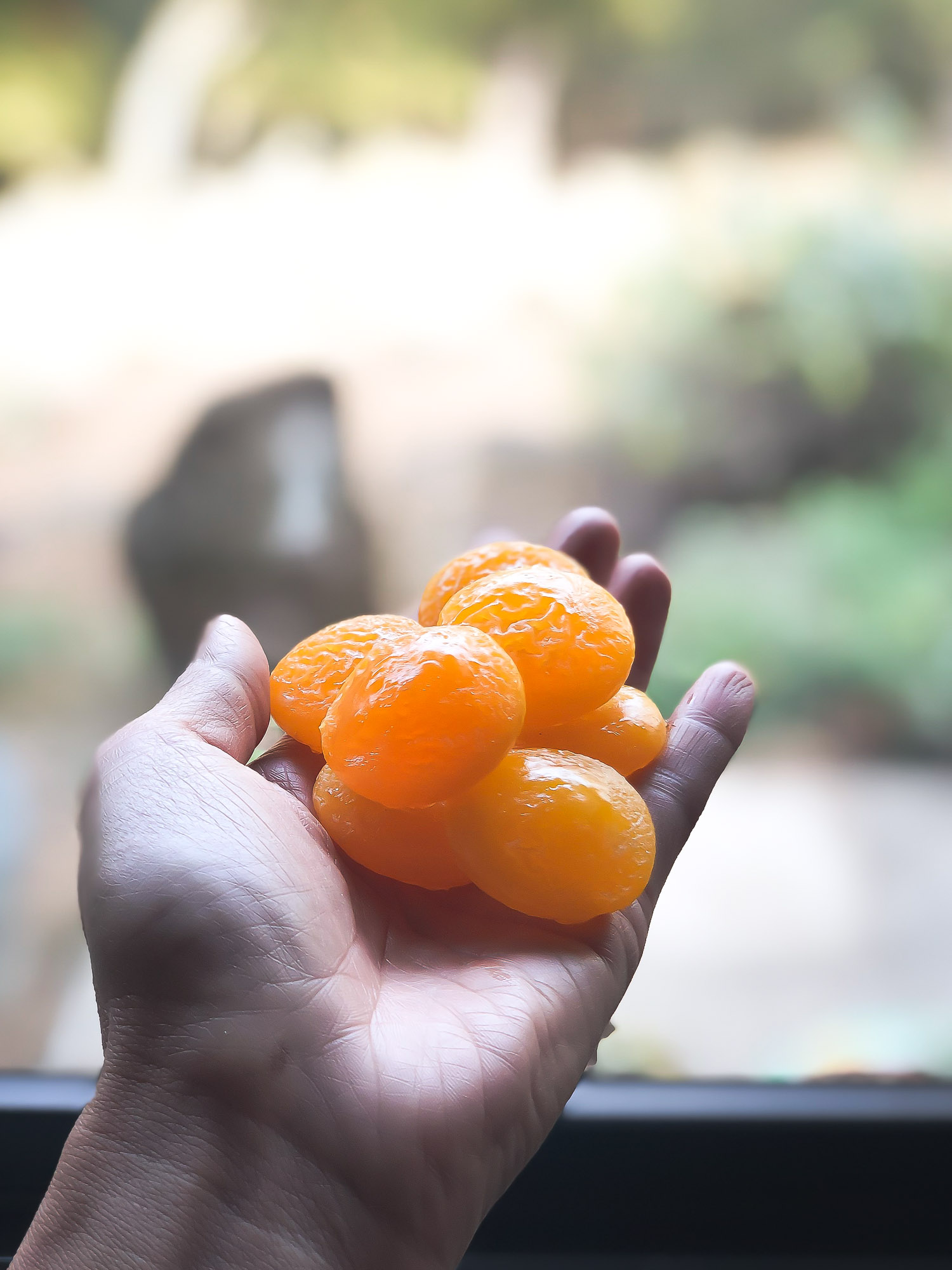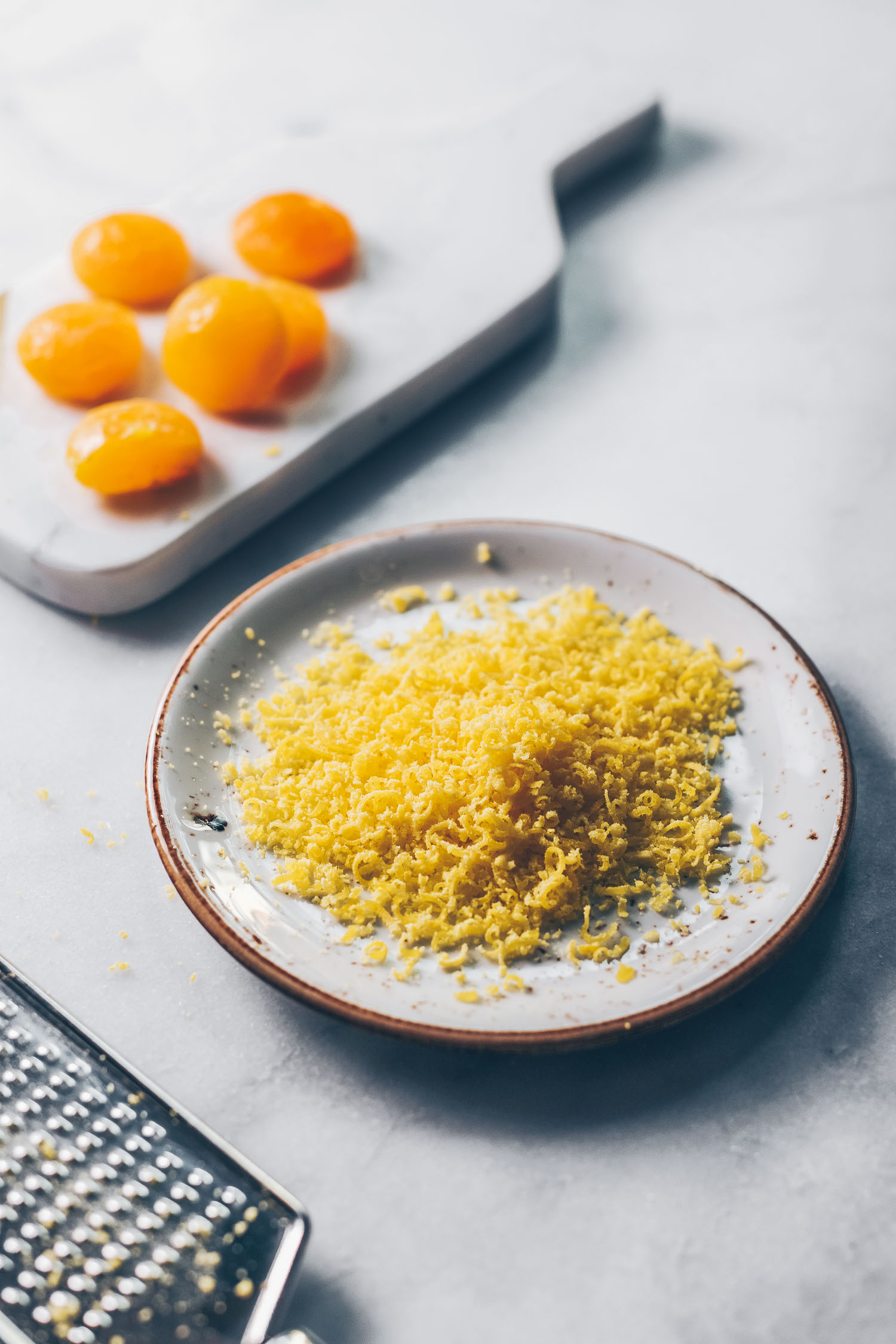Salt-Cured Egg Yolks
A classic Asian technique for eggs, these quick-cured egg yolks will add an umami boost to soups, salads, rice, pasta and even avocado toast.

A nest of eggs.
The days leading to our departure for a last-minute tropical Thanksgiving were a hectic blur. What with cleaning out the refrigerator, the laundry, the bills, tidying up for our house sitter, moving dozens of succulent arrangements in the yard in anticipation of rain, packing, it took some effort to keep the stress under control and get into the aloha spirit. I also tried to knock off two holiday recipes to share while we were away but time just wouldn’t allow it.

Five days later.
The recipes for Brussel sprouts and cranberry curd had to be pushed back but I’m glad the madeleines from my previous post were a winner along with these cured egg yolks.

After rinsing off the salt-sugar.
What are Salt-Cured Egg Yolks?
Salt cured eggs yolks have been making the rounds on the internet and social media for a few years and I’ve been intrigued and eager to give them a try. Preserving eggs in clay, mud or salty brine is a centuries-old Chinese tradition (there are Japanese and Filipino versions, too) but the process usually takes weeks.
Instead of using a whole raw egg in its shell, the idea of quick-curing just the egg yolks by burying them in a salt-sugar mixture and leaving them to cure for just a few days appealed to me. The process was too easy not to try and grating or shaving the dried, salty nuggets to finish a dish sounded like the perfect umami-boosting ingredient I needed in my kitchen arsenal.

After drying in the oven.
I imagined these cured yolks to be the (ovo) vegetarian’s answer to bottarga (salted, cured fish roe), one of my favorite ingredients.
In reality, they weren’t too far off the mark.

Ready to use.
I was raised in a Filipino household with itlog na maalat (salted eggs) making a regular appearance at the table. They are used in certain baked goods to add a salty element but most commonly as a fresh salad/condiment tossed with tomatoes and served alongside rice and meat, an easy way to perk up a simple dish.

What Do Salt-Cured Egg Yolks Taste Like?
These quick-cured eggs taste much like the salted eggs of my childhood–salty with an amplified egg flavor. They are drier and firmer in texture and because of this I envision so many more applications for them besides being a sidekick to tomatoes.

Uses for Salt-Cured Egg Yolks
So far I’ve enjoyed them as a topping for rice and salad but I can also see grating a yolk over a bowl of soup, pasta (imagine on carbonara or Alfredo sauce), roasted vegetables–and how about a new spin on avocado toast? Well, I thought I was being original here but a little googling revealed that Food & Wine had done avo toast with cured eggs before…apparently not an original idea but still a great one!
Lastly, the next time you’re stuck with a huge bowl of egg yolks after making French macarons, meringues or pavlova here’s your recipe to salvage the leftovers.

This post is photo-loaded but I wanted to show you the step-by-steps of this simple process. I’m already imagining another way to infuse more flavor into my next batch: smoked perhaps? Can’t wait.



Salt-Cured Egg Yolks
An old Asian technique for eggs, these quick-cured egg yolks will add an umami boost to soups salads, rice, pasta and even avocado toast.
Ingredients
- 1 3/4 cups kosher salt
- 1 1/4 cups granulated sugar
- 7 large egg yolks
- cooking spray
Instructions
-
Whisk the salt and sugar together in a bowl. Spread out about half of the salt-sugar mixture on a baking dish or tray and create depressions about one inch apart using one of the using an egg shell.
-
Place an egg yolk in each depression and cover using the remaining salt-sugar mixture. Use a light hand in sprinkling the mixture on top of the egg yolks to avoid breaking them. Wrap the dish in plastic wrap and store in the refrigerator for five days. (If you used extra large eggs, add an extra day.)
-
After five days: Preheat your oven to 150ºF and set a cooling rack on a baking sheet. Spray the rack with cooking spray. Carefully brush off the salt-sugar mixture from the eggs, rinse gently and pat dry. The yolks should be semi-farm at this point. Set on the rack and dry them in the oven for about 90 minutes. After their time in the oven the yolks will be dry, firm and opaque (the texture of gruyere cheese). Cool and grate/slice over salad, soup, rice and/or pasta. Will keep refrigerated for up to one month.
Recipe Notes
Adapted from Bon Appetit. Where the original recipe uses four egg yolks for this amount of salt and sugar I was able to cure seven egg yolks by using two smaller containers.










WOW!!! I remember seeing this in an old Chinese cookbook when I first started cooking. I’d completely forgotten about them. And you can grate them like bottarga??? Fabulous!!! I may not make them, but thank you for doing so.
These are so interesting! I’ve never heard of these before but love all the things you can do with them. Also your photos are fabulous. I will have to try these. Thanks so much for sharing.
These pictures make it look like the bomb!! I may actually get in the kitchen to make some! Christmas IS coming. And this would make every one smile! Thanks Jean!!
I wonder: can you retain the salt/sugar mixture for future batches after use?
Hi, Lisa. I’ve wondered the same thing but I haven’t saved any of my mixture for future uses so I can’t say. Eggs seem a safe thing but I’m really not sure so I’m afraid to encourage you to do it and be wrong. I also wonder how long the mixture would be good for since it does absorb moisture from the yolks. Sorry I’m not much help. If I come across definitive information I’ll update this post. Thank you! 🙂
Hi Jean,
I was so excited to see this recipe for salt cured egg yolks as my mother used to make a few dozen in extremely large glass jars using water mixed with food grade rock salt. You are right that it took weeks. She used them to make zongzi, glutinous rice stuffed with peanuts, Chinese sausage, dried shrimp, pork belly, and salt cured egg yolks wrapped with bamboo leaves, tied with string, and then simmered in stock pots for hours until they were done. Looking forward to making these soon!
Also, I’m looking forward to trying out your other recipes. Filipino friends in the U.S. introduced me to various dishes including Relyenong Bangus which was absolutely delicious!
Hi, Mabel. I’m so glad you stumbled upon my blog. If/when you do try this recipe, would love to hear how it went. Your mother’s zongzi sounds like something I would truly enjoy and reminds me of bringhe, the Filipino version of what you’ve described. And yes to relyenong bangus–so delish and I haven’t had it forever! Might be time to make a special requests from my parents. 🙂
Hey! I am quite short on time and need to use it in less than 3 days. Do you think I can get close to the solid state? Perhaps a little longer in the oven? HELP!
Hello. I have not tried a shorter curing time so I can’t advise on this, though your idea might work. Not sure how much of the salt/sugar will be infused into the yolks after only a couple of days of curing, however. Would love to know how it went if you ended up doing this. Thank you!
I had some yolks left over today from a buttercream recipe so I decided to try this. I infused the salt/sugar mix with some aromatics like coriander, peppercorns, sumac, bay leaves, fennel, a few other things, all toasted up and ground finely. First time trying this. Very excited. I am going to have a slight variation needed though because my oven only goes down to 170F. Wondering if that might be too warm.
I would think you could put the salt sugar mixture on a baking sheet and put it in the 150 degree oven when your doing the egg yokes. 150 degrees for 90 minutes will sterilize the salt sugar mixture. When the yokes come out take the baking sheet with the salt sugar mixture let cool and put in a clean container for the next time you make these.
Hello! My husband loves salt-cured egg yolks, they remind him of his childhood when his neighbor would cook using them. In your instructions, it says to dry them in the oven. I was wondering, is it possible to use a dehydrator? Thank you, I’m really looking forward to making these!
Hi, Sara. I haven’t used a dehydrator for this recipe. I’m thinking it should work if the temperature on the dehydrator is the same as or close to the oven temperature recommended here. Is that possible? I’m afraid I don’t have any experience with them but if you try it I’d love to know how it works out. Thanks so much for your interest in this recipe. 🙂
Can i use regular iodized salt? Or himalayan salt?
Hi, Maybel. This should be fine though I haven’t tried with other than sea salt.